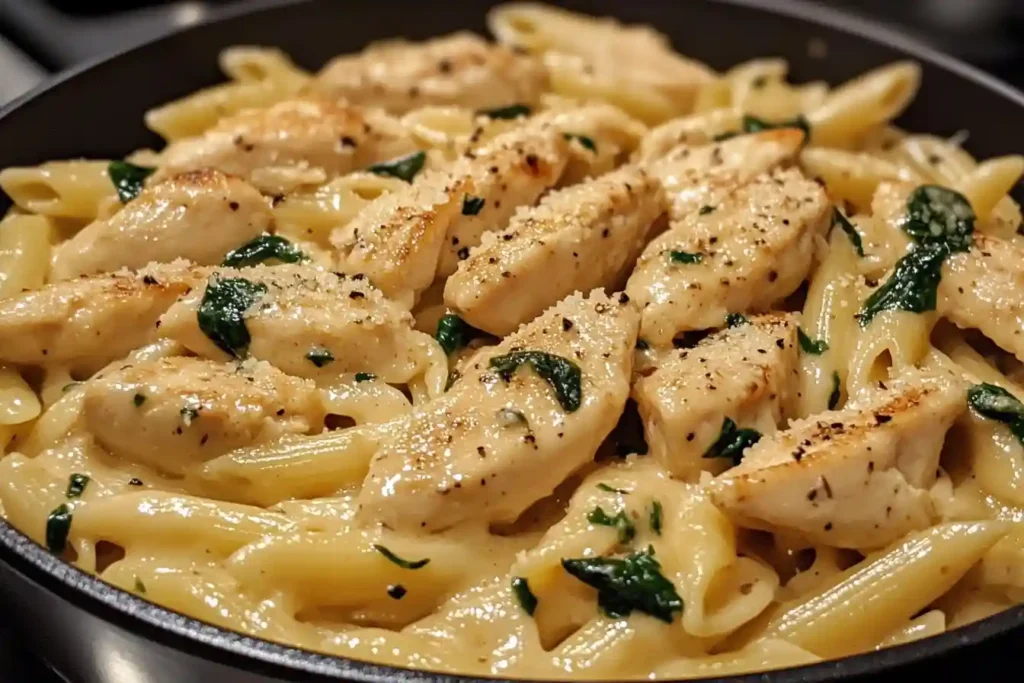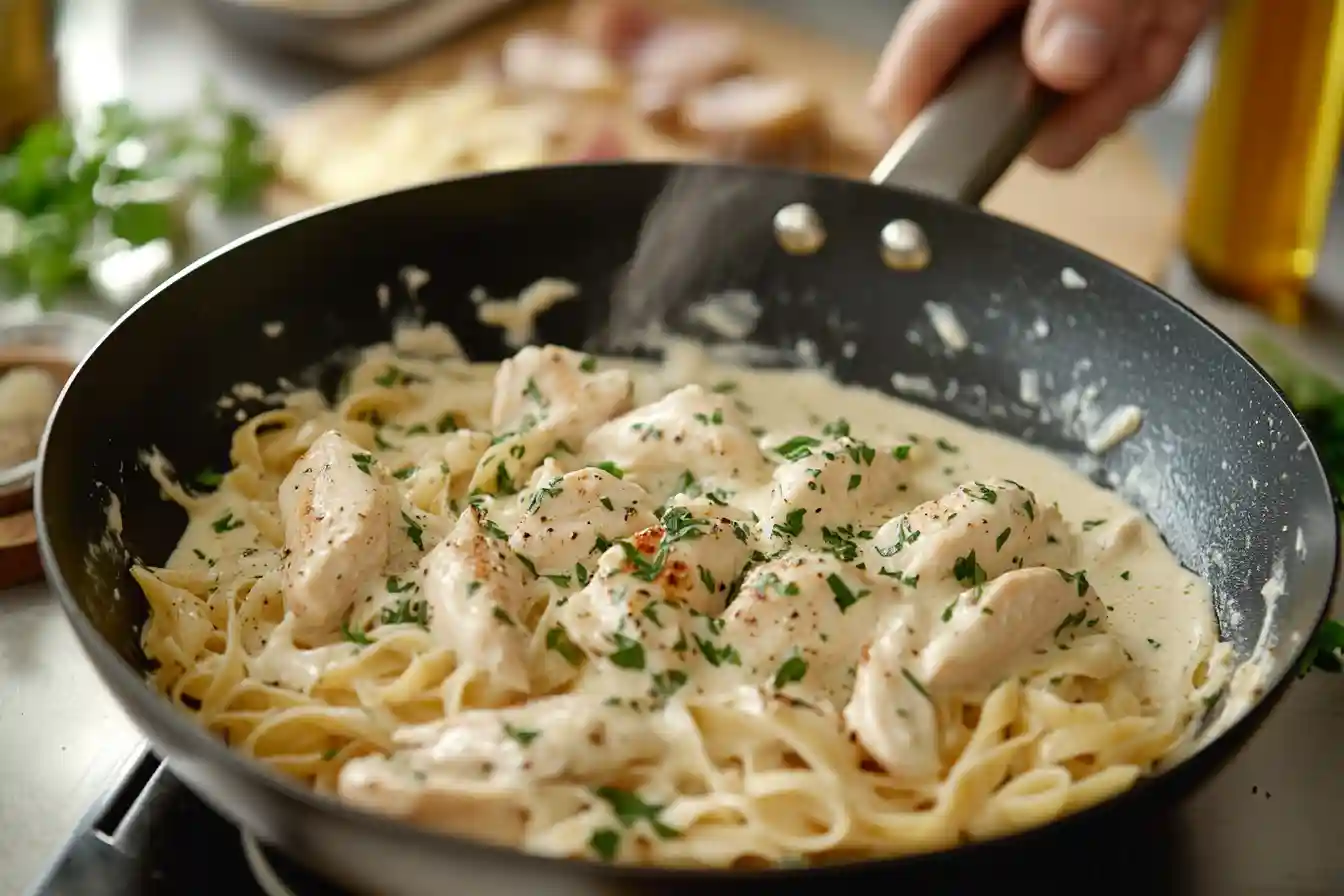Garlic parmesan chicken pasta is more than just a dish; it’s an experience that tantalizes your taste buds with every bite. This exquisite recipe combines the aromatic punch of garlic with the creamy, savory notes of parmesan cheese, all perfectly mingled with tender chicken and al dente pasta. Whether you’re preparing a family dinner or hosting a special gathering, this dish is designed to impress and satisfy. The magic lies in its balance—a harmonious blend of flavors that pays homage to traditional Italian cooking while adding a modern twist.
Table of Contents
Background and History
Garlic parmesan chicken pasta has deep roots in Italian cuisine, yet it has evolved over time to incorporate modern culinary trends. The fusion of garlic and parmesan is a nod to the traditional flavors found in Italian cooking. In many Italian households, garlic is a staple ingredient, prized not only for its distinct aroma but also for its health benefits. Parmesan, aged to perfection, adds a nutty, savory depth to dishes, making it a favorite among chefs and home cooks alike.
Italian Heritage
The Italian culinary tradition is rich with recipes that celebrate simplicity and quality ingredients. Garlic parmesan chicken pasta takes inspiration from classic Italian dishes where pasta is often the centerpiece. In traditional Italian kitchens, recipes were passed down through generations, and every ingredient was carefully chosen for its flavor and nutritional value. The use of fresh garlic and authentic parmesan cheese in this recipe is a testament to that heritage. Each component is selected to ensure that the final dish is both robust in flavor and balanced in taste. The emphasis on using local, high-quality ingredients speaks to the Italian philosophy of “less is more,” where every bite tells a story of culinary excellence and cultural pride.
Modern Adaptations
Over the years, garlic parmesan chicken pasta has undergone numerous adaptations to meet modern tastes and dietary needs. Contemporary chefs have experimented with the recipe, introducing innovative techniques and variations that enhance its classic flavors while adding new dimensions. For instance, some recipes incorporate a touch of cream or white wine to elevate the sauce, while others explore spice variations to give the dish an extra kick. These modern adaptations have not only broadened the appeal of the dish but have also made it accessible to a wider audience. Today, garlic parmesan chicken pasta stands as a perfect example of how traditional recipes can be reimagined to fit contemporary lifestyles, offering both comfort and sophistication in one plate.
Ingredients Overview
The secret to a spectacular garlic parmesan chicken pasta lies in the careful selection and preparation of its ingredients. This section provides an overview of the fresh and quality ingredients that form the foundation of the dish, along with valuable tips on substitutions for those with dietary restrictions.
Fresh and Quality Ingredients
For an authentic garlic parmesan chicken pasta, using fresh and high-quality ingredients is essential. The star components include:
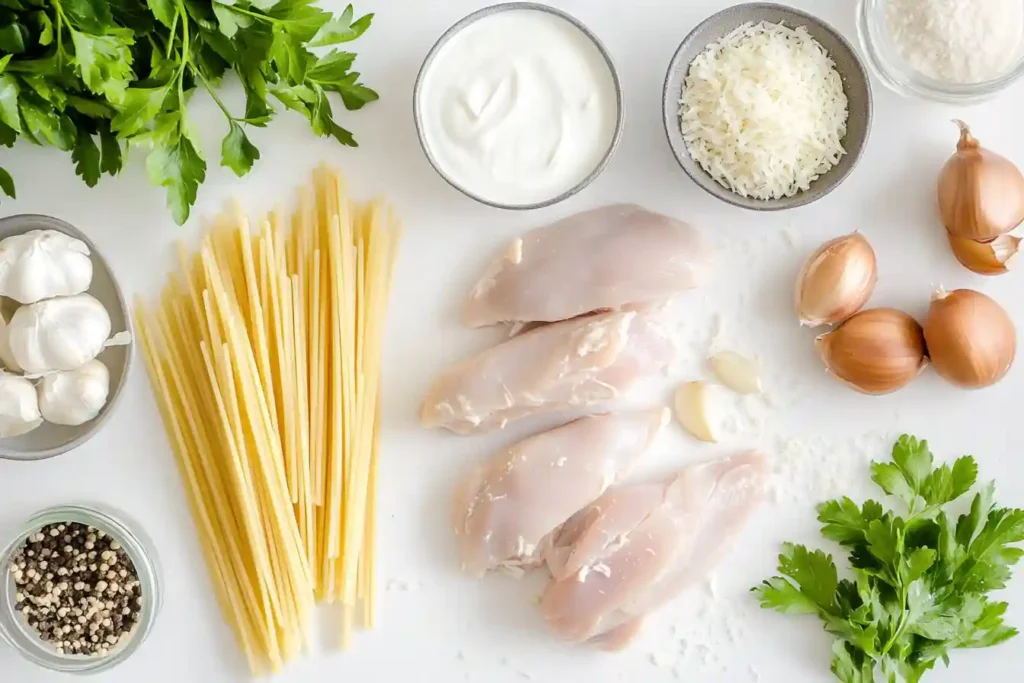
- Chicken: Opt for boneless, skinless chicken breasts or thighs for a tender, juicy outcome.
- Garlic: Fresh garlic cloves are preferred over pre-minced options, as they offer a more robust and aromatic flavor.
- Parmesan Cheese: Authentic, aged parmesan cheese adds a rich, nutty flavor that complements the garlic and chicken.
- Pasta: Choose your favorite type of pasta—fettuccine or penne are excellent choices that hold the sauce well.
- Fresh Herbs: Basil, parsley, or thyme can be added for an extra burst of flavor and color.
- Cream and Butter: These ingredients are used to create the creamy sauce that binds all the elements together. Using high-quality, fresh ingredients ensures that every bite is bursting with flavor and that the dish remains true to its Italian roots. When all ingredients are at their peak, the final result is a pasta dish that is both comforting and gourmet.
Substitutions for Dietary Restrictions
Not everyone can consume traditional dairy or gluten-based ingredients, but that shouldn’t keep you from enjoying garlic parmesan chicken pasta. Here are some substitution ideas:
- Gluten-Free Options: Replace regular pasta with gluten-free varieties made from rice, corn, or quinoa flour.
- Dairy Alternatives: For those who are lactose intolerant or vegan, dairy-free cheeses or plant-based creams can be used. Nutritional yeast might even be added to mimic the parmesan flavor.
- Lean Protein Variants: Substitute chicken with turkey or even tofu if you’re looking for a plant-based protein option. These substitutions ensure that the dish can be enjoyed by a wider audience without compromising on taste. The key is to maintain the balance of flavors, ensuring that the substitutes complement the traditional ingredients.
Step-by-Step Directions
Creating the perfect garlic parmesan chicken pasta involves a series of well-coordinated steps. This section breaks down the process into clear, manageable stages—from preparation to cooking—ensuring that every element is executed with precision.
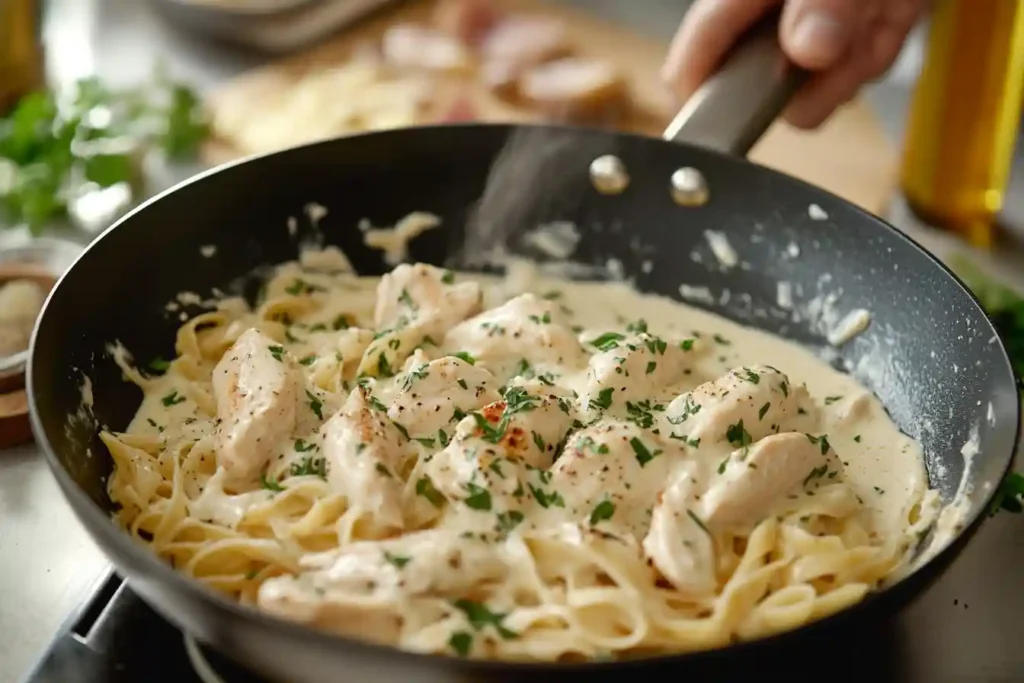
Preparation and Marinating
The first step in making this dish is proper preparation. Begin by gathering all your ingredients and ensuring they are at the right temperature and consistency. Cut the chicken into even-sized pieces to promote uniform cooking. Mince the garlic finely to release its full flavor potential, and grate the parmesan cheese if you are not using pre-grated varieties.
Marinating the chicken is a crucial step that infuses it with flavor and tenderness. A well-marinated chicken will absorb the aromatic notes of garlic, herbs, and spices, setting the stage for a flavorful meal.
Marinating Techniques
To marinate the chicken effectively:
- Combine Ingredients: In a large bowl, mix olive oil, freshly minced garlic, a pinch of salt, cracked black pepper, and your choice of herbs such as rosemary or thyme.
- Coat Evenly: Add the chicken pieces to the bowl, ensuring every piece is well-coated with the marinade.
- Rest Time: Cover the bowl and let it rest in the refrigerator for at least 30 minutes to 2 hours. This resting period allows the flavors to penetrate deeply into the meat.
- Stir Occasionally: Give the mixture a gentle stir halfway through the marination process to ensure all pieces are evenly exposed to the flavors. This technique not only tenderizes the chicken but also enhances its overall flavor profile, making it an integral part of the dish’s success.
Cooking the Chicken and Pasta
Once the chicken is marinated, it’s time to move on to the cooking phase. This stage involves two simultaneous processes: sautéing the chicken and boiling the pasta.
Sautéing the Chicken
Sautéing is a method that involves cooking the chicken quickly over high heat, ensuring that it remains juicy while developing a crisp exterior. Here’s how to do it:
- Preheat the Pan: Heat a large skillet over medium-high heat and add a splash of olive oil.
- Cook in Batches: Place the marinated chicken pieces in the skillet in a single layer. Avoid overcrowding the pan to ensure even cooking.
- Monitor the Cooking: Sauté the chicken for about 5-7 minutes per side until it reaches a golden-brown color. The internal temperature should reach 165°F for safe consumption.
- Rest the Chicken: Once cooked, transfer the chicken to a plate and cover loosely with foil to keep warm while you prepare the rest of the dish. This method ensures that the chicken develops a flavorful sear while staying moist and tender on the inside.
Boiling and Draining Pasta
While the chicken is cooking, start boiling the pasta:
- Bring Water to a Boil: Fill a large pot with water and add a generous pinch of salt. Bringing the water to a rolling boil is essential for the perfect pasta texture.
- Cook to Al Dente: Add the pasta and cook according to the package instructions. For garlic parmesan chicken pasta, aim for an al dente texture—firm yet tender.
- Drain and Reserve: Once the pasta is cooked, drain it well, reserving a small cup of pasta water. This starchy water can be added later to help bind the sauce if needed. This process ensures that the pasta is cooked evenly and retains a satisfying bite that complements the saucy chicken.
Creating the Creamy Sauce
The final element that ties the dish together is the creamy garlic parmesan sauce. This sauce is the heart of the recipe, offering a rich, velvety texture that coats every strand of pasta and every piece of chicken.
Emulsifying the Sauce
To create a smooth and cohesive sauce, follow these steps:
- Heat the Base: In the same skillet used for the chicken, lower the heat and add a knob of butter. Allow it to melt slowly.
- Incorporate Garlic and Cream: Add minced garlic to the butter, sautéing briefly until fragrant. Then, pour in a measured amount of cream, stirring continuously.
- Mix in Parmesan: Gradually add freshly grated parmesan cheese while stirring. The cheese will melt into the sauce, creating a creamy emulsion.
- Adjust Consistency: If the sauce seems too thick, add a splash of the reserved pasta water. Continue stirring until the sauce reaches a smooth, velvety consistency.
- Season to Taste: Finally, season with a little salt and freshly ground pepper, ensuring the flavors are balanced. This emulsification process is key to achieving a sauce that not only ties the dish together but also enhances the rich flavors of the garlic and parmesan, making each bite irresistibly creamy.
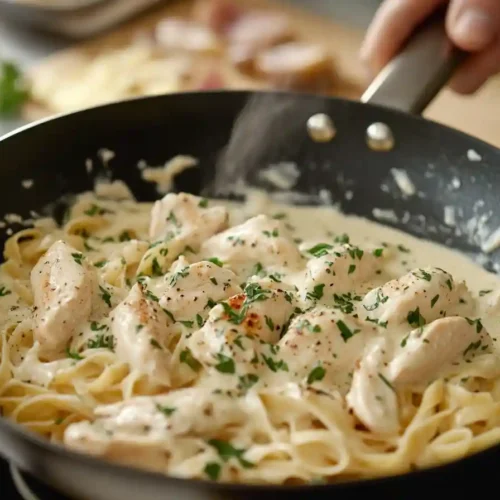
Garlic Parmesan Chicken Pasta
Ingredients
- Chicken:
- 500 g boneless skinless chicken breasts (cut into bite-sized pieces)
- Pasta:
- 300 g fettuccine or penne pasta
- Garlic & Aromatics:
- 4-5 garlic cloves minced
- Dairy & Sauce Components:
- 1 cup heavy cream
- 1/2 cup unsalted butter
- 1 cup freshly grated Parmesan cheese preferably Parmigiano-Reggiano
- Herbs & Seasonings:
- Fresh basil or parsley chopped
- Salt and freshly ground black pepper to taste
- Optional: A pinch of red pepper flakes for heat
- For Marinating:
- 2 tablespoons olive oil
- 1 teaspoon dried thyme or rosemary
- Optional Variations:
- For a baked version add an extra 1/2 cup of mozzarella cheese on top.
- Substitute lemon zest and a squeeze of lemon juice for a lemon garlic parmesan chicken twist.
- To incorporate potatoes garlic parmesan chicken and potatoes, add small roasted potato cubes.
Instructions
- Begin by cutting the chicken into uniform, bite-sized pieces. Mince the garlic finely and grate the Parmesan cheese if not pre-grated.
- Marinating the Chicken:
- In a bowl, combine chicken pieces with olive oil, minced garlic, dried thyme (or rosemary), salt, and pepper.
- Let the chicken marinate for at least 30 minutes (up to 2 hours in the refrigerator) for enhanced flavor.
- Cooking the Pasta:
- Bring a large pot of salted water to a boil. Add the pasta and cook according to package instructions until al dente.
- Reserve 1 cup of pasta water and then drain the pasta thoroughly.
- Sautéing the Chicken:
- In a large skillet, heat a splash of olive oil over medium-high heat.
- Cook the marinated chicken in batches to avoid overcrowding. Sauté for 5-7 minutes per side until golden brown and cooked through (internal temperature should reach 165°F).
- Once done, remove the chicken and keep it warm.
- Creating the Creamy Garlic Parmesan Sauce:
- In the same skillet, lower the heat and add the butter.
- Once melted, add the remaining minced garlic and sauté briefly until fragrant.
- Pour in the heavy cream and stir continuously.
- Gradually add the grated Parmesan cheese, stirring to form a smooth and cohesive sauce.
- If the sauce thickens too much, slowly add some of the reserved pasta water to adjust the consistency.
- Season with salt, pepper, and optional red pepper flakes.
- Combining the Ingredients:
- Return the sautéed chicken to the skillet, then add the cooked pasta.
- Toss everything together until the pasta is evenly coated with the garlic parmesan sauce and the chicken is well distributed.
- Finishing Touches:
- Garnish with freshly chopped basil or parsley.
- For the baked variation, transfer the mixture to a baking dish, sprinkle mozzarella cheese on top, and bake in a preheated oven at 375°F for 10-15 minutes until the cheese is melted and bubbly.
- Serving:
- Serve immediately while hot. For added flavor, provide lemon wedges on the side for those who prefer a lemon garlic parmesan chicken twist.
Notes
Experiment with a lemon garlic parmesan chicken version by adding lemon zest and juice.
For a heartier meal, mix in roasted potatoes for garlic parmesan chicken and potatoes.
External Reference:
Nutrition
Nutritional Information and Health Benefits
Understanding the nutritional benefits of garlic parmesan chicken pasta adds another layer of appreciation for this dish. While it is indulgent and rich in flavor, there are several nutritional positives to consider.
Garlic is renowned for its antioxidant properties and its ability to support cardiovascular health. Parmesan cheese, when used in moderation, provides a good source of calcium and protein. Chicken is a lean protein that contributes to muscle health, and pasta offers a sustained release of energy. When paired with fresh herbs and a controlled amount of cream and butter, this dish can be part of a balanced diet.
Moreover, by opting for substitutions like gluten-free pasta or dairy alternatives, you can tailor the dish to fit various dietary requirements without losing the essence of the original recipe. The combination of protein, healthy fats, and carbohydrates makes this pasta dish a satisfying meal that can fuel your day while providing essential nutrients.
In summary, the first half of this article has taken you on a journey from the rich heritage of garlic parmesan chicken pasta, through the selection of premium ingredients, to the step-by-step process of preparing, cooking, and creating a luxurious sauce. Every element, from marinating the chicken to emulsifying the sauce, is designed to ensure that you achieve a dish that is both traditional and innovative. By understanding these key aspects, you are now well-equipped to create a meal that is as nutritious as it is delicious.
Variations and Customizations
Garlic Parmesan chicken pasta is a versatile dish that welcomes creative twists. While the classic recipe offers a perfect balance of savory garlic, creamy parmesan sauce, and tender chicken, there are several exciting variations to suit different tastes and dietary needs. For those who enjoy a hearty baked version, consider the garlic parmesan chicken pasta bake. In this variant, the ingredients are layered in a casserole dish and baked until the top becomes beautifully golden and slightly crispy, offering a delightful textural contrast.
Spicy and Savory Variants
For spice enthusiasts, the recipe can be adjusted to mimic flavors found in popular dishes such as the buffalo wild wings garlic parmesan chicken pasta recipe. A dash of hot sauce or a sprinkle of red pepper flakes can be added to the sauce, providing an extra kick that balances the rich, creamy texture. Similarly, a variant known as lemon garlic parmesan chicken introduces a bright citrus note into the sauce, cutting through the richness with a refreshing burst of flavor. These twists not only add variety but also appeal to those who enjoy experimenting with their favorite recipes.
Vegetarian and Gluten-Free Alternatives
Adapting the dish for vegetarian or gluten-free diets is both simple and satisfying. For a meatless option, substitute chicken with tofu or a plant-based protein that can absorb the flavors of the garlic parmesan sauce. Additionally, swap traditional pasta with gluten-free alternatives made from rice, corn, or quinoa flour to create a creamy chicken pasta easy version that still offers the comforting taste of the original dish. Another inventive alternative is tuscan chicken pasta, where a blend of sun-dried tomatoes and spinach is introduced, appealing to those who enjoy a Mediterranean flair while keeping the dish robust and nutritious.
Innovative Twists on Sides and Pairings
Some culinary enthusiasts prefer to pair their pasta dish with complementary sides. A creative variation is garlic parmesan chicken and potatoes, where roasted potatoes are added either as a side or incorporated into the main dish. This combination not only elevates the dish’s heartiness but also introduces an additional layer of texture and flavor. Likewise, inspired by recipes such as golden grace kitchen chicken garlic parmesan pasta, some cooks have found that integrating a medley of seasonal vegetables transforms the meal into a colorful and balanced feast.
Troubleshooting and Expert Tips
Even with a straightforward recipe, occasional challenges may arise in the kitchen. Understanding common issues and having a set of expert tips at hand can ensure that your garlic parmesan chicken pasta turns out perfectly every time.
Common Cooking Challenges
One frequent concern is achieving the ideal texture for both the chicken and the pasta. Overcooked chicken can become dry, while pasta that is too soft can undermine the dish’s overall appeal. To avoid these pitfalls, it is crucial to monitor the cooking time carefully and ensure that the chicken is sautéed in batches, preventing overcrowding in the pan. This technique, reminiscent of methods used in golden grace kitchen chicken garlic parmesan pasta, helps maintain the juiciness and tenderness of the meat. Another common issue is the sauce breaking or becoming too thick. The key is to stir continuously and add a little reserved pasta water as needed to achieve a smooth and cohesive consistency for the garlic parmesan sauce.
Expert Cooking Tips
Seasoning is paramount in this recipe. Freshly ground pepper and a pinch of salt can significantly enhance the flavors. When preparing the sauce, it is essential to allow the parmesan to melt slowly into the cream, forming a stable emulsion. For an extra dimension of flavor, consider incorporating a splash of white wine into the sauce during the reduction process. This technique not only deepens the taste but also mirrors the finesse seen in more elaborate dishes like tuscan chicken pasta. Additionally, for those interested in exploring more innovative recipes, you might find inspiration by checking out recipes such as the French Onion Chicken Crock Pot—a dish that shares similar depth in flavor and simplicity in preparation.
Serving Suggestions and Pairings
Presentation and pairing are just as important as the cooking process itself. Thoughtful serving suggestions can elevate a simple pasta dish to an unforgettable dining experience.
Side Dishes and Salads
Pairing garlic parmesan chicken pasta with a well-chosen side dish can create a balanced and complete meal. A crisp, green salad with a light vinaigrette provides a refreshing contrast to the creamy sauce. Consider adding seasonal vegetables like cherry tomatoes, spinach, or arugula to your salad for extra color and flavor. For a heartier option, a side of garlic parmesan chicken and potatoes—where roasted potatoes are seasoned with similar herbs and spices—can be served alongside the pasta, ensuring that every bite is satisfying and well-rounded. If you’re interested in exploring more dinner ideas for hectic evenings, you might enjoy our collection of sheet pan dinners for busy weeknights, which offer quick and delicious alternatives.
Beverage Pairings
When it comes to beverages, white wines such as Pinot Grigio or Sauvignon Blanc are excellent choices to complement the creamy and savory nature of the dish. These wines have enough acidity to cut through the richness of the garlic parmesan sauce, balancing the meal. For a non-alcoholic option, a lightly sparkling water with a hint of lemon can echo the subtle citrus notes found in the lemon garlic parmesan chicken variant. Alternatively, for those looking to add an extra twist to their appetizer lineup, the Instant Pot Buffalo Chicken Dip makes for a fantastic starter that pairs well with the main dish, offering a burst of flavor and a playful contrast.
Presentation and Plating Ideas
An appealing presentation can significantly enhance the dining experience. Thoughtfully arranged plating not only highlights the vibrant colors and textures of the dish but also makes it more inviting.
Garnishing Techniques
A sprinkle of freshly chopped parsley or basil adds a pop of color and a burst of fresh flavor to garlic parmesan chicken pasta. Consider garnishing the dish with a drizzle of olive oil and a light dusting of extra parmesan, echoing the rich garlic parmesan sauce. For added flair, a few lemon wedges on the side not only contribute a bright, contrasting color but also allow diners to add an extra zing to each bite, particularly if they are enjoying a lemon garlic parmesan chicken twist. The key is to balance aesthetics with functionality—ensuring that every garnish enhances the overall flavor and presentation of the dish.
User Reviews and Testimonials
Feedback from fellow food enthusiasts plays a vital role in refining any recipe. Many home cooks have shared glowing testimonials about their experiences with garlic parmesan chicken pasta. One user remarked on the transformation achieved by trying a garlic parmesan chicken pasta bake, noting that the baked version offered a delightful crispiness that perfectly complemented the creamy sauce. Another enthusiastic reviewer compared their version to the buffalo wild wings garlic parmesan chicken pasta recipe, praising the recipe’s balance of spice and creaminess. These authentic testimonials highlight how subtle variations can elevate the dish to new culinary heights.
Users also appreciate the flexibility of the recipe. Some have experimented with tuscan chicken pasta variations by incorporating sun-dried tomatoes and spinach, while others have kept it classic. The ability to tweak the dish—whether by substituting proteins or altering the sauce consistency—ensures that every cook can personalize their meal to their exact liking. Additionally, many have shared their experiences on community platforms and recipe blogs, contributing valuable insights that help others avoid common pitfalls. Such shared experiences not only foster a sense of community among food lovers but also solidify the dish’s status as a versatile and beloved classic.
Frequently Asked Questions (FAQs)
Below are some of the most common questions about garlic parmesan chicken pasta, along with detailed answers to help clarify any doubts and enhance your cooking experience.
Where did chicken Parmesan come from?
Chicken Parmesan, or Chicken Parmigiana, has its roots in Italian-American cuisine. It evolved from the traditional Italian dish, Parmigiana di Melanzane (eggplant Parmesan), where the concept of layering fried ingredients with cheese and tomato sauce was adapted using chicken. This adaptation became popular in the United States, merging Italian culinary traditions with American tastes. For a detailed history, you can learn more about Chicken Parmesan on Wikipedia.
What’s the difference between Parmesan chicken and chicken Parmesan?
The terms “Parmesan chicken” and “chicken Parmesan” are often used interchangeably, yet subtle differences exist. Traditionally, chicken Parmesan involves breading and frying the chicken before baking it with tomato sauce and cheese. In contrast, Parmesan chicken might refer to recipes where the chicken is prepared without a heavy breading, focusing more on a saucy, baked preparation. This variation allows for a lighter, yet equally flavorful dish, such as the creamy chicken pasta easy variant, which maintains the rich flavors without the extra calories from frying.
Why do people like chicken Parmesan?
Chicken Parmesan is a crowd-pleaser because it strikes a perfect balance between savory, tangy, and creamy flavors. The combination of juicy chicken, aromatic garlic, and the rich, nutty taste of parmesan cheese creates a multi-layered taste experience. This dish also offers versatility, as it can be adapted into different forms—from a classic fried version to a baked casserole like garlic parmesan chicken pasta bake. Its comforting flavors and satisfying textures make it a beloved choice for family dinners and special occasions alike.
How do Italians say chicken Parmesan?
In Italian, chicken Parmesan is typically referred to as “pollo alla Parmigiana.” This name reflects the dish’s heritage and the emphasis on quality ingredients, such as authentic Parmigiano-Reggiano cheese, which is integral to the dish’s flavor profile.
What is the best cheese to use in garlic parmesan sauce?
For the richest flavor and smoothest texture, authentic Parmigiano-Reggiano is the cheese of choice. Its sharp, nutty taste is essential to creating a well-balanced garlic parmesan sauce that elevates the entire dish.
Can I make garlic parmesan chicken pasta ahead of time?
Yes, this dish can be prepared in advance. If you’re planning to reheat it later, it’s best to store the components separately—the pasta, chicken, and sauce—to preserve the texture and flavor. When reheating, do so gently on the stove or in the oven to avoid overcooking the chicken or causing the sauce to separate.
Conclusion
In conclusion, garlic parmesan chicken pasta stands as a testament to the versatility and depth of Italian-inspired cuisine. From the classic sautéed version to innovative twists like the garlic parmesan chicken pasta bake and lemon garlic parmesan chicken variant, there’s a version to suit every palate. With careful attention to ingredients and technique—whether following tips inspired by golden grace kitchen chicken garlic parmesan pasta or adopting adjustments from the buffalo wild wings garlic parmesan chicken pasta recipe—this dish promises to deliver both comfort and culinary sophistication.
